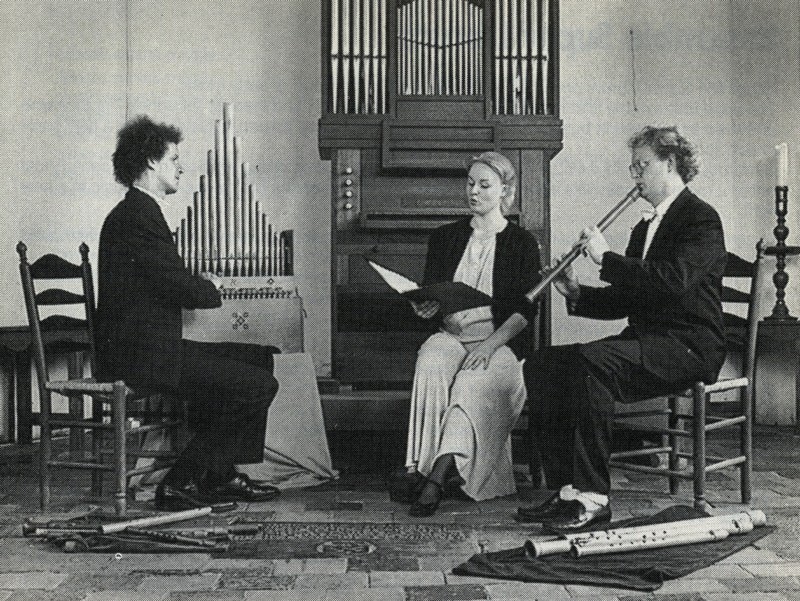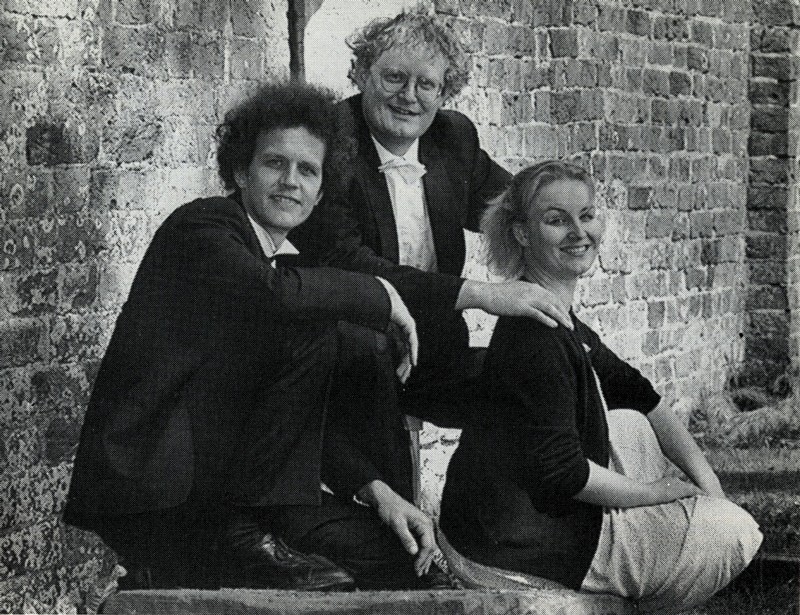Intabulation and improvisation in the 14th century
Ensemble Super Librum

medieval.org
Sonclair CD JB 128 836
1988
1. Adesto Sancta Trinitas [2:33]
Philippe de VITRY
2. Adesto Sancta Trinitas [2:22]
Robertsbridge Codex
3. De toutes flours [5:32]
Guillaume de MACHAUT
4. De toutes flours [2:57]
Codex Faenza
5. Istanpitta [6:35] Ensemble Super Librum
Francesco LANDINI
6. Viditi, donna [3:09]
7. Duolsi la vita [2:17]
8. Duolsi la vita [1:38]
9. Per allegreçça [1:15]
10. Que ti çova nasconder [3:52]
Codex Rossi
11. A ricolta bubu [5:56]
Lorenzo da FIRENZE · improvised
12. Aquila altera ~ Creatura gentil ~ Uccel de Dio [3:58]
Jacopo da BOLOGNA
13. Aquila altera [2:59]
Codex Faenza
misa breve · Codex Faenza
14. Christe eleison [1:13]
15. Glorificamus te [1:20]
16. Domine Deus, Agnus Dei, Filius Patris [0:44]
17. Amen [0:47]
18. Amen [1:41] Ensemble Super Librum
ENSEMBLE SUPER LIBRUM
Susanne Norin, mezzo-soprano
Jankees Braaksma, organetto — recorder (#13, 14, 16)
Ronal Moelker, recorder — organetto (#1, 2, 8)

About the music
We
can often deduce the popularity of vocal works from the fact that
instrumental arrangements (intabulations) of them have been preserved.
These intabulations originated through improvisation, in which the
original vocal work was varied with ornaments.
Churches still lacked
large organs in the 15th c. but they often had organetti, which are
small portative organs. These portative organs were used to accompany
the Mass.
The motet Adesto Sancta Trinitas by Philippe de
Vitry is included in the political satire 'Le roman de Fauvel'. The
three voices of the motet symbolize The Holy Trinity. The intabulation
is played on two organetti.
The subject of Guillaume de Machaut's ballade De toutes flours
is the rose, a well known symbol of good fortune at the time. In our
setting we place the words in the tenor, the lowest voice. The original
composition as well as the intabulation from the Faenza Codex are
introduced by an improvised prelude.
The style of the virtuoso instrumental Instanpitta
originated in the melismas in Gregorian chant and the embellishments in
14th c. vocal music, as in the two part ballate in the Rossi Codex.
These lnstanpitte, of which only one manuscript is preserved (Ms Lo
29987), derive from a long tradition of improvisation. Being true
minstrels, we play our own Instanpitta, following the style of the Istanpitte from the London Manuscript and the ballate from the Rossi Codex.
The greatest portative virtuoso of the Trecento was Francesco Landini. His death coincides with the end of the trecento.
The ballata Che ti çova Nasconder derives directly from Gregorian chant.
The
organetto (portative organ) was also popular in those days because it
could be played with a 'drone', like a bagpipe or a hurdy-gurdy.
A ricolta bubu
is inspired by folkmusic; the improvisation with a drone-effect is
based on musical material from this piece and on the Istanpitte from the
London Manuscript.
A performance of the madrigal Aquila altera is described in Prudenziani's 'Il Solazzo' (1410-1420); it must have been a famous composition. The intabulation of Aquila altera
shows that instrumental music of the late 14th c. was performed with
great virtuosity. The original composition as well as the intabulation
from the Faenza Codex are introduced by short improvised preludes.
The
program ends with a short Mass compiled from the Faenza Codex. The
contrast between rhythmic, Gregorian melodies and free, ornamented
counterpoint gives this music a very modern air.
The last piece, Amen, is an own composition using the original style.

Ensemble Super Librum
Ensemble Super Librum occupies a special place in the world of early music.
The
ensemble's name is borrowed from the 15th c. composer and theorist
Johannes Tinctoris who preferred improvisation based on a composed
melody (super librum) to playing from a fully composed score.
By
introducing techniques of improvisation that once were common but which
in the past century lost out to a more business-like approach to
performance, the ensemble places early music in a new light.
Ensemble
Super Librum performs on recorders and organetti (portative organs),
reconstructed from paintings and descriptions of the 14th and 15th c.
The
instruments have medieval acoustical characteristics and are, together
with the voice of Susanne Norin, responsible for the transparent
sound-colour of the ensemble.
In 1985 the ensemble was invited to
a symposium on improvisation practise in the late middle ages as the
first stage of a new research program at the Schola Cantorum Basiliensis
in Switzerland. In 1986 the ensemble won the First Prize in the
International Competition for Early Music Ensembles in Amersfoort
(Holland).
In 1987 they won an award in the Musica Antique Concours in Bruges (Belgium).
In
1988 the ensemble appeared in the Festival for Medieval Music in Skara
(Sweden) as well as in the Holland Festival for Early Music in Utrecht
(Holland).
The Musicians
Jankees Braaksma
studied recorder at the Conservatories of Groningen and Amsterdam. With a
scholarship from the city of Groningen he studied late medieval
improvisation at the Schola Cantorum Basiliensis (Switzerland) in 1982-
1983.
Ronald Moelker studied recorder at the Rotterdam
Conservatory and the Royal Conservatory in The Hague. In 1987 he won
prizes at the Second International Early Music Concours in Amersfoort
(Holland).
Susanne Norin studied classical singing at the Stockholm Conservatory.
She
specialised in the performance of early music at the Schola Cantorum
Basiliensis. At the moment she is connected with the Schola as a teacher
of singing.
Instrumentarium
Recorders made by Sverre Kolberg, Oslo, Norway
· Alto in g', in maple, a=460 (1988)
· Alto in g', in boxwood, a=412 (1986)
· Two tenors in c', in maple, a=460 (1988)
· Bass in F, in maple, a=460 (1981)
Tuned according to the natural tone scale with C as the 4th note
Organetti (portative organs) made by Winold van der Putten, Zwolle, Netherlands
· Organetto after a painting from Fra Angelico (1387-1455) in the Museo
San Marco, Firenze. a=440/460; cedarwood; pipes: 95% lead (1988)
· Organetto after paintings from Hans Memling (1433-1494), in the Museum
voor Schone Kunsten, Antwerpen and Jan van Eyck (1390-1441), in the
Sint Baafskathedraal, Gent (1983). Pipes after descriptions of Arnout
van Zwolle (ca. 1450).
b'-a-, a=415, 440, 460; dutch oak; pipes: 95% lead
Both organetti have a pythagorean tuning according to Arnout van Zwolle
Recording data:
sept. 3 and 4, 1988 at the gothic church of Garnwerd, province of Groningen, Netherlands.
Recording Engineer: Jos Boerland
Used equipment:
Soundcraft Series 6000 mixing console
Sony PCM 2500 professional DAT recorder
2 x Neumann KM 84
1 X Neumann U 87
2 x AKG C 460 + ULS 62 microphones
mastered at Sony PCM 1630 and DAE 1100 A editor
The principal recording is done directly real time full stereo, therefore sound quality is as bright and natural as possible.
DDD mastered by: REC geluidsregistraties, Veendam, NL
Musical arrangements, text and producer: Jankees Braaksma
Frontcover: Studio Dorèl, Groningen
Photos: Studio Hans van Dijk, Groningen
Translation of the poetry: Anneke Buikema, Groningen
With special thanks to: Sverre Kolberg, Norway.


